BWR: Sport and Science Meet
Published on January 23rd, 2015
(January 23, 2015; Day 24) – Sport met science today on the Barcelona World Race when the pairs of skippers took the first opportunity to deploy their data monitoring Argo beacon which was given to them in Bareclona prior to the start.
Even the duos in the gnarly south were fairly quick to follow the launch protocol as requested by Race Direction and set their beacons adrift on the Southern latitudes. Inded it was second placed Guillermo Altadill and José Munoz which launched their beacon at 1100hrs UTC today at 44 deg 07 S. By midafternoon four crews had deployed their beacons which will provide data from these remote oceanic locations for seven years.
Science: Beacons are launched
The Argo programme allows scientists to look below the surface, providing a profile of the temperature and salinity of the ocean using a global array of over 3,500 profiling floats that are moving up and down in the water column from the surface to a depth of 2,000m. Argo makes visible large-scale ocean and climate features and processes that were once hidden to scientists. The network has enabled new revelations about ocean dynamics that are helping society understand and forecast global climate.
Guillermo Altadill explained today from Neutrogena:
“Everything we can do in terms of contributing to more knowledge of the ocean is good. We all know this area is not a place where it is easy to drop these Argo floats for the scientific community. But here we are sailing on these seas and it is quite easy for us to make a little effort so we can have more knowledge of the oceans and to have more information.”
Echoing his sentiments, Kiwi Conrad Colman commented from Spirit of Hungary: “The buoy will plunge to over 2000 meters in depth, taking water samples to test for temperature, salinity and other indicators. As sailors we are naturally hugely affected by the changes in the weather so it feels great to be able to contribute to its greater understanding during our race.”
Maintaining this network is very challenging and requires 1,000 deployments per year. The eight floats for the Barcelona World Race flee t were funded by Coriolis (France).
JCOMMOPS specialists, who coordinate the maintenance of the network and initiated this innovative partnership, have been following the race very closely to choose the best day: and today is that day, the weather conditions allow for a safe launch, and the position of the boats is optimal to deploy floats in remote areas where there is little coverage, and consequently little data.
This program is initiated by UNESCO-IOC in partnership with JCOMMOPS,Coriolis (France) and the Barcelona Foundation for Ocean Sailing (FNOB).
Sport: Neutrogena chipping back miles in the south.
While race leaders Cheminées Poujoulat have stepped slightly south with four gybes in the last couple of days, Neutrogena continue to exploit the more direct route in the south, paralleling the exclusion zone in better, stronger breeze than that of the race leaders Bernard Stamm and Jean Le Cam.
Guillermo Altadill and José Munoz have caught up from being computed to be 209 miles behind the pacemakers, to a delta of just 87 miles. The north south divide between the two leaders has been cut by half and while Altadill again confirmed he is happy with their positioning, he sounded like he would like to move to be on the same system as the leaders, when the time and opportunity arises.
“Now we may try to move closer to Cheminées Poujoulat in terms of latitude, to sail in the same meteo system as them, because it’s quite risky to sail in a different meteo system. We Will try to do it and get closer to them, and we have to negociate the depression coming from behind, to find a place where we have wind but not too much neither too many big seas that don’t allow to sail fast.” said Altadill.
Stronger winds are expected for all of the top three boats, GAES Centros Auditivos in the middle lane between the two leaders, albeit 500 miles back, has had over 30kts today much more like the ‘brochure’ conditions of the south. Cheminées Poujoulat could see a gusty 40kts for a time.
Skippers quotes:
Guillermo Altadill (ESP) Neutrogena:
“We were in a system where all the routings show us to sail as close as possible to the exclusion zone, even it showing we should sail a little south of it to get better pressure, we try to sail along the line as much as we can, there is more pressure to the south of the line, now we gybed and are sailing a little bit north but just parallel to the line.
“It is typical conditions today, grey skies big waves, almost all the days are the same. By night you cannot see the moon, there is no horizon for reference, it is black, but day it is like a grey day in the winter of Europe, it is cold and sometimes there are big waves. The only thing you can see in the sky is the Albatross flying along the top of the waves.
“Everything we can contribute to more knowledge of the ocean is good. We know all of this area is not a place where it is easy to drop these Argo floats for the scientific community, we ar sailing on these seas and it is quite easy for us to make a little effort so we can have more knowledge of the oceans and to have more information.
“It’s always good to help the science and to help to avoid more pollution at sea. Two days ago we enter a current line and we found diesel cans, fishing nets… It’s very unusual. This is pollution.”
Any big decision for next days?
“No. Now we have to wait to see how all is being developed and what is coming from behind us. Now we may try to move closer to Cheminées Poujoulat in terms of latitude, to sail in the same meteo system as them, because it’s quite risky to sail in a different meteo system. We Will try to do it and get closer to them, and we have to negociate the depression coming from behind, to find a place where we have wind but not too much neither too many big seas that don’t allow to sail fast.”
Anna Corbella, ESP GAES Centros Auditivos:
“It means a lot to us both to do what we can to help the scientific community while we are sailing this race. And for Gerard and me it is something else interesting because it makes us happy to help. We will make a little ceremony to throw the beacon in the water. We are going to write something on it, a message but we don’t know exactly what we are going to write yet.”
You’re already in The Roaring Forties? How is it?
“Yes, full on it is. We got in a couple of days ago and it’s brutal because we’ve changed from summer to winter in just 24 hours. Right now it is pretty good, we have 25 knots of wind and we wait for a new front tonight, which will be our first front even if the other day we had some rain and pretty strong wind. The truth is the boat is going well, we are going well too although we’ve had some problems but we keep going, just fixing everything and going on.
“Right now we are in a rain squall, we had 25 knots but right now there are 30 kts and there there is Gerard standing out there, I don’t know if we need to make a reef. You can see its grey the sea temperature has dropped to 15 degrees and the ambient one is about 15 degrees too. So, wet and grey!”
Ranking at 14:00 UTC:
1. Cheminées Poujoulat (Bernard Stamm – Jean Le Cam) 18277.2 nm Distance to Finish
2. Neutrogena (Guillermo Altadill – Jose Muñoz) 87.4 nm Distance to Lead
3. GAES Centros Auditivos (Anna Corbella – Gerard Marin) 537.5 nm DTL
4. Renault Captur (Jörg Riechers – Sebastien Audigane) 1080.3 nm DTL
5. We Are Water (Bruno Garcia – Willy Garcia) 1421.6 nm DTL
6. One Planet One Ocean / Pharmaton (Aleix Gelabert – Didac Costa) 1732.3 nm DTL
7. Spirit of Hungary (Nandor Fa – Conrad Colman) 2016.9 nm DTL
Hugo Boss (Alex Thomson – Pepe Ribes) Abandon
Report by event media.
Background: The third edition of the Barcelona World Race is the only double-handed, non-stop, round the world race. Eight IMOCA 60 teams started December 31, 2014, with the intent to cover 23,450 nautical miles in a circumnavigation from Barcelona to Barcelona, putting the capes of Good Hope (South Africa), Leeuwin (Australia) and Horn (Chile) to port and the Antarctic to starboard. The finishes are forecasted for the end of March 2015.


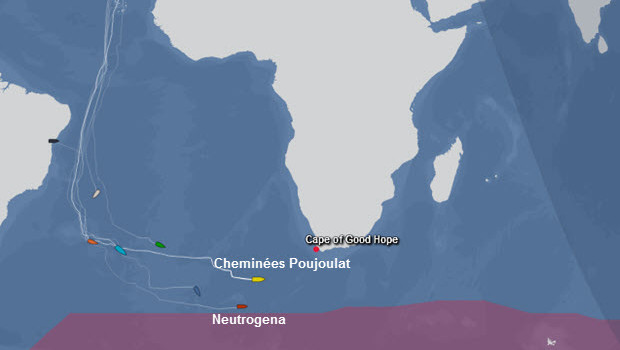



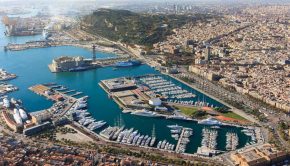
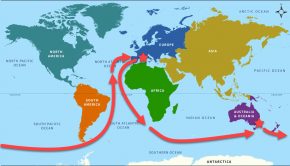
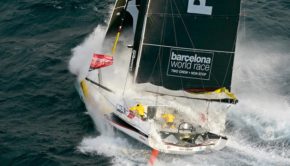
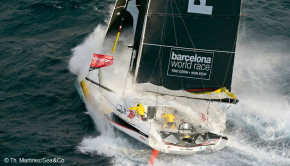
 We’ll keep your information safe.
We’ll keep your information safe.